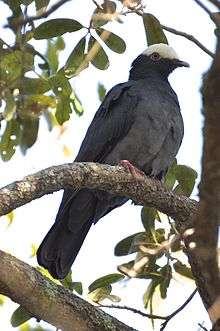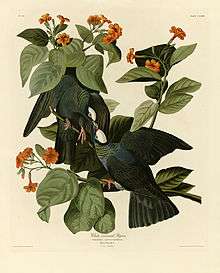White-crowned pigeon
| White-crowned pigeon | |
|---|---|
 | |
| In Florida, USA | |
| Scientific classification | |
| Kingdom: | Animalia |
| Phylum: | Chordata |
| Class: | Aves |
| Order: | Columbiformes |
| Family: | Columbidae |
| Genus: | Patagioenas |
| Species: | P. leucocephala |
| Binomial name | |
| Patagioenas leucocephala (Linnaeus, 1758) | |
| Synonyms | |
The white-crowned pigeon (Patagioenas leucocephala, formerly Columba leucocephala) is a species of bird in the family Columbidae (doves and pigeons).[2][3] It inhabits the northern and central Caribbean islands and some places on the North and Central American mainland. John James Audubon painted the pigeons, including the watercolour in his work Birds of America, published in the early 19th century.


The white-crowned pigeon can measure 29–35 cm (11–14 in) in length, span 48–59 cm (19–23 in) across the wings, and weigh 150–301 g (5.3–10.6 oz). It is around the same size as the common rock pigeon, but weighs a bit less since it is generally less chunky and has a relatively longer tail.[4][5] The adult is dark grey, with green and white bars on the nape, a brilliant white crown to the head, a white iris, and a pale-tipped red bill. Juveniles are a less dark shade of grey, lack the nape pattern and white iris, and show only a few pale feathers on the crown. The song is a series of mourning dove-like woo pop woooo calls; this species is a member of a diverse clade of Patagioenas which vary much in appearance, but are united by their triple coos (except in the scaled pigeon).[2][6]
It is a resident breeder mainly in the Bahamas, Cuba, Jamaica and Antigua. It breeds in smaller numbers in Hispaniola, Puerto Rico, the Virgin Islands, the Cayman Islands, Anguilla and other Caribbean islands. It also breeds along the Caribbean coast of Central America. In the United States it is found only in the Florida Keys and the southern tip of mainland Florida.
The main threat to this species is hunting. In Florida a major cause of mortality is collision with man-made objects. Another main threat to this species is loss of habitat. The white-crowned pigeon needs two distinct habitats, one for nesting and one for feeding. They typically breed in coastal red mangroves (Rhizophora mangle), which continue to be clear-cut for crops such as sugarcane. Agriculture and deforestation have become a problem for the species' feeding grounds, typically inland hardwood forests. The bird is very skittish, and is known to simply abandon its nest when it is encroached upon.
Like the extinct passenger pigeon this species "illustrates a very important principle of conservation biology: it is not always necessary to kill the last pair of a species to force it to extinction. These birds are "threatened by the slaughter of nesting birds on its Caribbean breeding grounds."[7]
References
- ↑ BirdLife International (2012). "Patagioenas leucocephala". IUCN Red List of Threatened Species. Version 2013.2. International Union for Conservation of Nature. Retrieved 26 November 2013.
- 1 2 Johnson, Kevin P.; de Kort, Selvino; Dinwoodey, Karen, Mateman, A. C.; ten Cate, Carel; Lessells, C. M. & Clayton, Dale H. (2001). "A molecular phylogeny of the dove genera Streptopelia and Columba" (PDF). Auk. 118 (4): 874–887. doi:10.1642/0004-8038(2001)118[0874:AMPOTD]2.0.CO;2.
- ↑ Brands, S. J. "Columba leucocephala". Systema Naturae 2000. Retrieved July 22, 2005.
- ↑ Gibbs, David, Pigeons and Doves. A&C Black (2001), ISBN 978-1-873403-60-0
- ↑
- ↑ Mahler, Bettina; Tubaro, Pablo L. (2001). "Relationship between song characters and morphology in New World pigeons". Biological Journal of the Linnean Society. 74 (4): 533–539. doi:10.1006/bijl.2001.0596.
- ↑ Ehrlich, Paul R.; Dobkin, David S.; Wheye, Darryl (1988). "The Passenger Pigeon". Stanford University. Retrieved March 3, 2012.
External links
| Wikimedia Commons has media related to Patagioenas leucocephala. |
